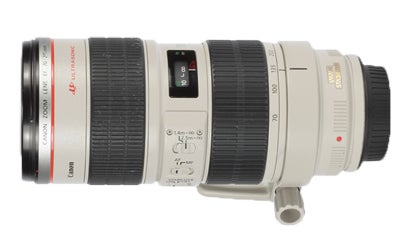Canon EF 70-200mm f/2.8L IS USM Review
Canon EF 70-200mm f/2.8L IS USM Review
Canon EF 70-200mm f/2.8L IS USM lens review - What Digital Camera tests this ergonomic delight...

Verdict
Pros
- Shaped switches allow 'blind' selection of Image Stabilisation
Cons
- 200mm MTF results
Key Specifications
- Review Price: £1550
It should come as no surprise to learn that Canon’s professional-specification Canon EF 70-200mm f/2.8L IS USM zoom lens is an ergonomic delight. It sits comfortably in the hand and its controls all fall naturally within fingertip reach.
The zoom ring is rearwards and has a quarter-turn throw; the focusing ring is further forwards and rotates through about 130 degrees to reach its 1.4m minimum object distance. Both collars have secure rubber grips and the mechanisms inside are perfectly balanced. Automatic focusing is brisk and quiet.
Thanks to a raised edge on the appropriate slider, Canon’s image stabilisation (IS) system can be activated with an unseen flick of the left thumb. The mechanism is audible but very quiet and highly effective: it works well to settle the viewfinder image for easier composition when longer focal-lengths are set and improves the quality of captured images.

The IS mode selector, like the focus limiter, is slightly recessed to prevent accidental movement and offers a choice of static-use or panning stabilisation. The former employs two-dimensional image stabilisation whereas the latter does not attempt to stabilise continuous movement in the direction that the camera is turned to track a moving object.
Optical testing returned excellent results for the 70mm and 135mm focal-length settings with the standard short rise in MTF at wide apertures followed by a gradual tail-off later. Peak resolution, from f/5.6 to f/8, was very impressive at around 0.37 cycles-per-pixel. It is a shame that there was a drop in performance recorded at 200mm but, even so, the MTF results remain good overall.
Using the lens on a higher-specification camera body might well improve the results and if all of the figures were raised to the level of the shorter focal lengths then this lens would be unparalleled among its peers.
The lens that has been tested here is the latest IS version, but if you are on a budget or feel that image stabilisation is an option that you can live without then there is also a less expensive non-IS version that might be more attractive. Expect to pay around £1,500 for the fully-equipped lens and around £1,000 for the non-IS incarnation.
Trusted Score
Score in detail
-
Value 10
-
Design 10
-
Image Quality 9
-
Features 10

